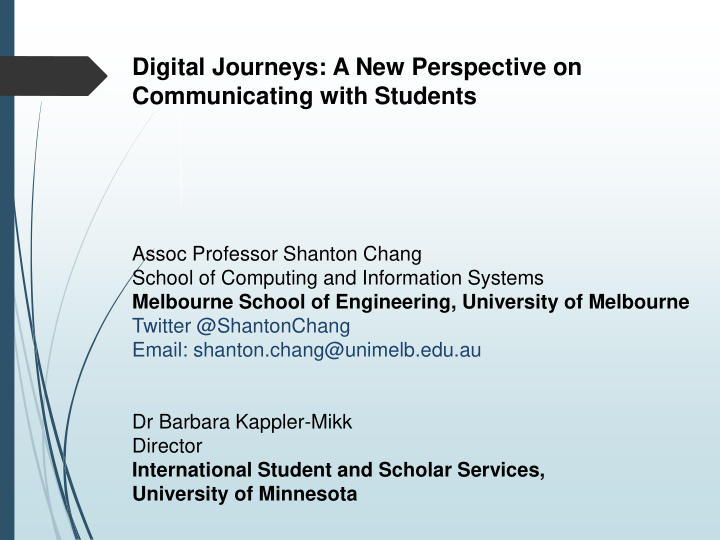



Digital Journeys: A New Perspective on Communicating with Students Assoc Professor Shanton Chang School of Computing and Information Systems Melbourne School of Engineering, University of Melbourne Twitter @ShantonChang Email: shanton.chang@unimelb.edu.au Dr Barbara Kappler-Mikk Director International Student and Scholar Services, University of Minnesota
How is the World Changing? How many websites are you accessing regularly? How many social media websites do you use? How many Apps do you use regularly? Online – do you mix business and social? Regular: Consistent and repeated use over and over again over a week
Digital Natives Popular ideas that digital natives are synonymous with Gen Y who; have achieved high rates of digital literacy, are globally aware and connected love technology can be self-serving and self-focused What does the research actually say? Digital literacy is patchy and information seeking skills may be limited to google Engagement with social media is heterogeneous Social networks are mainly based on real world networks They do love technology Participate in all sorts of social online campaigns
But not everyone is ‘equal’ on social media Online Participant Role Example SNS Features Reader / Member Entry and exit, View, Browse, Search Lurkers Contributor Rate, Tag, Review, Post, Upload Likers Establishing relationships, Collaborator Cooperating, Linkers Collaborating, Communicating Leader Promoting, Mentoring, Leaders Governing Table 1: Site features according to role (adapted from Preece and Shneiderman, 2009)
If there is so much information out there, why aren’t we more educated or informed as a society? Recognised and Demanded Recognised and Undemanded Information Needs Information Needs Unrecognised and Demanded Unrecognised and Undemanded Information Needs Information Needs Alzougool, Chang and Gray (2013)
How is the World Changing?
Differences in Digital Environments between Home and Host Country
Check this out The University of Tokyo http://www.u-tokyo.ac.jp/en/index.html Now – go to the top right “Language” and click the first option (which is Japanese) – What do you get?
Digital Journeys Digital Journey ‘refers to the transition that an individual makes online from relying on one digital bundle of sources to the other new bundle, perhaps based on the new host country or internationally’ Chang and Gomes (2016, 2017).
Digital Journeys Journey suggests the act of travelling from one place to another Digital Journeys therefore represent the act of moving between digital spaces, finding new spaces and new digital “homes” Key Concepts related to Digital Journeys; Self-identity (Role, Tribe and Belonging) Making the Journey (Convenience, Comfort Zone, Safety, Trust, Emotional Attachment, Devices and Platforms, Digital Skills)
Self-Identity Role: Who am I? Online Tribes: Who are my people? Is there anyone in the new digital environment I can trust?
Making the Journey Convenience and Comfort Zone: Online, people choose what is easiest to do. Safety and Trust: Do sojourners trust new sources of information when previous home sources have served them so well? Emotional Attachment: Emotional attachment and loyalty to digital sources of information are very real. This is further enhanced by the community that they might have built online in home countries. Devices and Platforms: Does the digital journey include a shift in the use of different devices? What does it mean to be using a different platform in a host country? What are the technological impacts of trying to access new sites via new devices and platforms? Digital Skills: Do the sojourners have the digital skills to be able to transcend new sites and new information systems and language online?
References Shanton, C. & Gomes, C. (2017) International Student Identity and the Digital Environment. In B. Kappler Mikk & I. Steglitz (eds.) Learning across cultures: Locally and globally (3 rd edition). NAFSA, Washington D.C. Shanton, C. & Chang, C (2017) Digital Journeys: A Perspective on Understanding the Digital Experiences of International Students. Journal of International Students , 7(2): 347-366. U of Minn Welcoming Video: z.umn.edu/connectionvideo2021 U of Minn Data and Research Projects: http://global.umn.edu/icc/resources/umntc-ugis-data/index.html
Recommend
More recommend